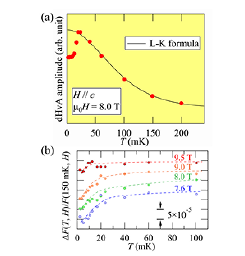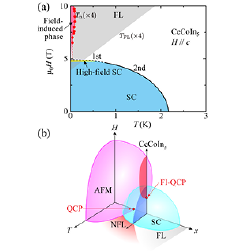Anomalous Change in the de Haas-van Alphen Oscillations of CeCoIn5 at Ultralow Temperatures
H. Shishido, Y. Yanase, and M. Yamashita
A very strange quantum behavior is found in a strongly-correlated superconductor at unprecedented ultralow temperatures [1]. The heavy-fermion compound CeCoIn5 is the celebrated, one of the most-studied d-wave superconductor [2]. Its unconventional superconductivity has been thought to be arisen by quantum fluctuations near the magnetically ordered state. However, in spite of many efforts, the ordered state has yet to be discovered.

Fig. 1. (a) The temperature dependence of the dHvA amplitude of α3 branch of CeCoIn5. The solid line shows the fit of the data from the standard Lifshitz-Kosevich formula. (b) The temperature dependence of the normalized shift of the dHvA frequency ΔF(T, H) / F(150 mK, H) of α3 branch. The data are shifted for clarity. The dashed lines are guides for the eye.

Fig. 2. (a) The H-T phase diagram of CeCoIn5. Field-induced phase found by our measurements (pink), the Fermi liquid (FL) region (gray), the superconducting (SC) phase (blue), and the high-field SC phase (yellow) are shown. Both Tn (the red circles) and TFL are multiplied by 4 for clarity. (b) A schematic H–T–x phase diagram near the AFM QCP, where x denotes pressure or chemical substitution. The cross section corresponds to the H–T phase diagram of CeCoIn5, in which a presumed field-induced QCP (FI QCP) is also shown at the intersection with the AFM boundary.
By using our home-made nuclear-demagnetization cryostat at ISSP, we performed the de Haas-van Alphen (dHvA) measurements of CeCoIn5 down to 2 mK. In a normal metal, a dHvA amplitude increases with a lowering temperature in accordance with the Lifshitz-Kosevich (LK) formula. However, in CeCoIn5, we unexpectedly find that the dHvA amplitudes deviate from the LK formula and show an anomalous decrease with a shift of the dHvA frequencies below a transition temperature Tn (Fig. 1). This anomalous change suggests that the long-presumed ordered state is finally discovered at ultralow temperatures unreachable for conventional cryostats.
The revised H–T phase diagram of CeCoIn5 (Fig. 2(a)) reveals that the field-induced AFM phase is located at the boundary of the unconventional superconductivity. Given that the field-induced phase is observed at very low temperature, the H–T phase diagram of CeCoIn5 at ambient pressure may be considered to be a cross section at the vicinity of the AFM QCP in the H–T–x phase diagram (Fig. 2(b)) obtained by the pressure dependence of the H–T phase diagram of CeRhIn5 [3]. Thus, our study shows that CeCoIn5 is a prominent superconductor where the interplay of unconventional superconductivity, magnetic order, and non-Fermi liquid behaviors near the QCP can be studied without the ambiguity caused by the application of pressure or chemical doping.
We also find that the transition temperature Tn depends on field only weakly for 7–10 T even though the Zeeman energy at 10 T is about 3 orders of magnitude larger than kBTn. This field dependence implies that AFM order is enhanced by suppressing the critical spin fluctuations in the vicinity of the AFM QCP in high fields, which gives rise to the weak field dependence of Tn, as supported by the FLEX calculation [4].
Future studies for the detailed structure of the newly-found state would reveal the origin of the unconventional superconductivity in the proximity of a magnetically ordered state. As demonstrated by this study, we believe that the development of the ultralow-temperature measurements has extensive potential to shed a new light on unexplored phenomena.
References
- [1] H. Shishido et al., Phys. Rev. Lett. 120, 177201 (2018).
- [2] K. Izawa et al., Phys. Rev. Lett. 87, 057002 (2001).
- [3] J. L. Sarrao and J. D. Thompson, J. Phys. Soc. Jpn. 76, 051013 (2007).
- [4] Y. Yanase, J. Phys. Soc. Jpn. 77, 063705 (2008).
